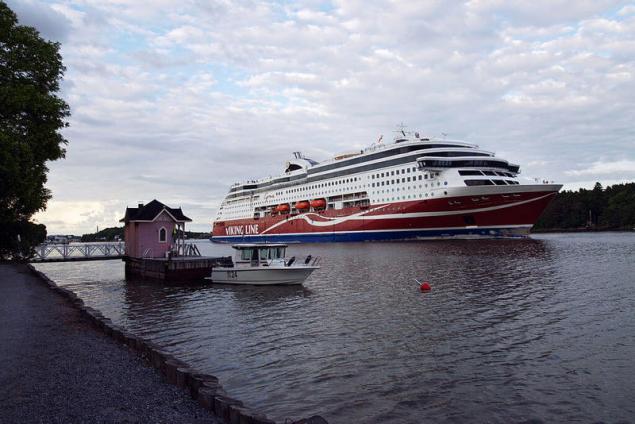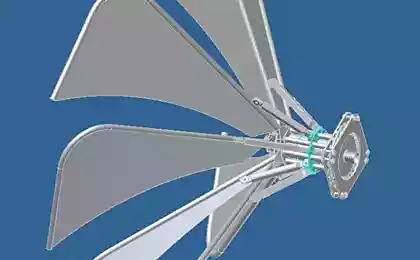581
The first hybrid passenger liner uses wind energy
Cruise liner Viking Grace will be the world's first hybrid passenger vessel and will use wind energy with the main power plant.
The vessel was built in 2013 for plying on the route Stockholm (Sweden) — Turku (Finland). The prototype used in this technology Rotor Sail Solution is turboprop, or a rotor sail, developed and patented in 1922, Anton Flettner. The invention of a German engineer was named "Flettner Rotor" and spawned a whole class retorsion — rotor ships using as a propulsion characteristic of the device. However, to large scale development in Maritime transport, the case came only in the twenty-first century.

Used in the new liner design is a modernized version of the Flettner rotor. It is a hollow cylinder with a height of 24 meters and a width of only 4 meters. During operation of turbopause cylinder rotates around its axis. Based on the work of the propeller lies a physical phenomenon in which the flow of air around a rotating body creates additional power. In other words, if you install a rotating cylinder (tube) and place it on open space (deck) to blow with the wind, the wind pressure on the cylinder many times will increase. This effect allows you to move the ship with much more momentum than when using the classical bulky sails. This phenomenon is called the Magnus effect.
Preliminary studies promise significant reductions in fuel consumption and hence emissions, according to a press release from the company Viking Line. The liner uses as fuel liquefied natural gas (LNG). Its consumption is when you use the install Rotor Sail Solution will be reduced by 300 tons per year. On the saved amount of steam can go three days or more, depending on weather conditions.Thus, most eco-friendly ship in the region will become even more "green". The combination of one vessel of the CNG engine, the electric drive of the propeller, the special shape of the case, not forming a great wave, and rotary sails — not found anywhere else in the world.
Technology Rotor Rail Solution has already been tested on cargo ships, resulting in turboprop was the "Innovation of the year" at the exhibition of Electric and Hybrid Marine World Expo in Amsterdam in 2016. Currently are working on implementation of a system for Viking Grace; they will be completed in 2018 installing turbopause. published
P. S. And remember, only by changing their consumption — together we change the world! ©
Source: ecotechnica.com.ua/transport/1999-pervyj-gibridnyj-passazhirskij-lajner-ispolzuet-energiyu-vetra.html
The vessel was built in 2013 for plying on the route Stockholm (Sweden) — Turku (Finland). The prototype used in this technology Rotor Sail Solution is turboprop, or a rotor sail, developed and patented in 1922, Anton Flettner. The invention of a German engineer was named "Flettner Rotor" and spawned a whole class retorsion — rotor ships using as a propulsion characteristic of the device. However, to large scale development in Maritime transport, the case came only in the twenty-first century.

Used in the new liner design is a modernized version of the Flettner rotor. It is a hollow cylinder with a height of 24 meters and a width of only 4 meters. During operation of turbopause cylinder rotates around its axis. Based on the work of the propeller lies a physical phenomenon in which the flow of air around a rotating body creates additional power. In other words, if you install a rotating cylinder (tube) and place it on open space (deck) to blow with the wind, the wind pressure on the cylinder many times will increase. This effect allows you to move the ship with much more momentum than when using the classical bulky sails. This phenomenon is called the Magnus effect.
Preliminary studies promise significant reductions in fuel consumption and hence emissions, according to a press release from the company Viking Line. The liner uses as fuel liquefied natural gas (LNG). Its consumption is when you use the install Rotor Sail Solution will be reduced by 300 tons per year. On the saved amount of steam can go three days or more, depending on weather conditions.Thus, most eco-friendly ship in the region will become even more "green". The combination of one vessel of the CNG engine, the electric drive of the propeller, the special shape of the case, not forming a great wave, and rotary sails — not found anywhere else in the world.
Technology Rotor Rail Solution has already been tested on cargo ships, resulting in turboprop was the "Innovation of the year" at the exhibition of Electric and Hybrid Marine World Expo in Amsterdam in 2016. Currently are working on implementation of a system for Viking Grace; they will be completed in 2018 installing turbopause. published
P. S. And remember, only by changing their consumption — together we change the world! ©
Source: ecotechnica.com.ua/transport/1999-pervyj-gibridnyj-passazhirskij-lajner-ispolzuet-energiyu-vetra.html
Scientists laid the Foundation for solar cells of a new type
In Russia, create a super-heavy aircraft on cryogenic fuel























